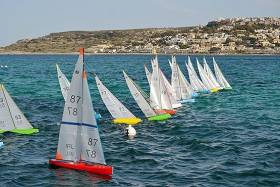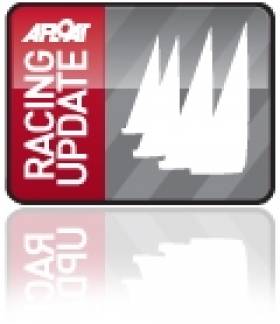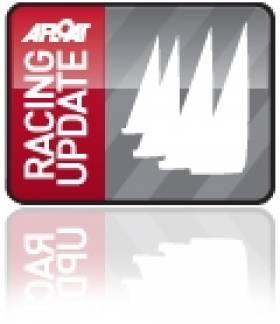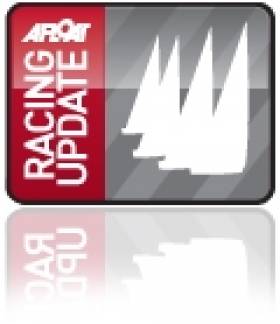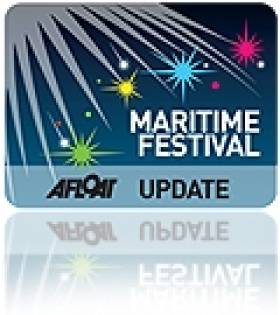Displaying items by tag: Model Boats
Model Yacht Racing Report From The Irish IOM Fleet
IOM ranking - Birkendhead/UK 5th March
Jeff and Stephen Kay of Howth Yacht Club took part in one of the big racing events in the UK recently. In Birkenhead there were 21 boats altogether and Jeff managed a podium in 3rd place with Stephen ending up with a very respectable 10th place.
Pretty good results as putting them in perspective in that fleet was the former World champion Rob Walsh and other top ranking skippers at European and World Championships. So a pretty tough bunch of skippers to sail with.
Full results here
2016 IOM Malta Open – Malta 17th-20th March
Stephen then went on to compete at the 2016 Malta Open and recently returned from it.
It was his first serious event with his new Britpop design (he sailed his V9 design at Birkenhead) and while he found his pace to be on part with the top skippers the lack of experience in starts with a full fleet of boats costed him a lot of points.
Being a small fleet of us here sailing regularly mean that we know each other well and so can becomes 70% match race vs fleet race as we know who is good in what conditions and we have much more room at the start too.
I experienced this also few months ago competing in France. If you allow yourself to get swallowed by the pack on the line you’ll get spit out at the back very quickly. Experience is key there and I can be safe in saying like with any other boat classes, full size or RC the race starts 5 minutes before the actual start.
You need to be quick to react to situation and find plan B or C very quickly too.
Talking to Stephen, the wind was tricky with lots of shifts and puffs and lulls resulting in numerous changes of places throughout each races. This made rounding that first mark ahead so crucial as once the pack arrived that weather mark could become very crowded very quickly and that’s a risk to loose big. An elevated piloting area made it easier for the skippers to see their boats.
There were a number of nationalities at this event which was won by a German followed by 8 UK skippers with the first skipper from Malta finishing 10th. Stephen finished an honorable 23rd out of 42 boats.
This shows the dominance of the UK Skippers in Europe making them one of the toughest fleet. As I said earlier about Birkendhead… to put things in perceptive!
What is also worth mentioning is that if you look at the results it is no long a clear dominance from the Britpop design anymore as there is a clear spread of designs in across the results. Which means that other designers have catch up to Brad’s BP design and leveled the playing field once again providing close racing as we want. Download results below.
Coming up…
Gilbert will be travelling to France and will race at a regatta on the 10th April but with a restored boat so it will be interesting to see the outcome.
18 Model Boats Skippers Contest Ulster IOM Title
#modelboats – Despite an uneasy weather forecast and torrential rain during the week model boat skippers heading for the Ulster IOM championships just couldn't complain about the weekend as we had light wind, a good few sunny spells and no rain at all writes Gilbert Louis.
With this in mind we had more skippers than last year's Ulster's championships. They came from the Republic, Northern Ireland, Scotland and England, 18 in total.
Saturday saw the whole fleet of 18 boats sailing together. Despite talks of splitting into 2 fleets the decision was made to keep us all in one fleet which has one key advantage. We get twice as many race and time on the water and this is part of sailing.
The format was sets of 3 races pretty much back to back with only a few minutes for skippers to make adjustments if needed between the races, to tune their boats to the conditions. Or giving an opportunity for quick fixes in case of brakeage.
Then a longer break before the next set of 3 races. This format allowed us to spend great time on the water and get the most of the day sailing not watching others sail. Everyone enjoyed it.
Sure it also made for spectacular starts ! 18 boats on the starting line is not something we're used to so you have to be on the first line or you get spat out at the back very quickly after the start. This is excellent training for us as we don't have that experience in Ireland but that's what they do at international levels so a good exposure for us.
The trick is to be amongst the front line of boats in the last few seconds before the start. You need to make your space and defend it. Not easy when you're in your boat, even more difficult when you have your boat in a swarm of other boats all looking to have the perfect start.
The start and first beat to the weather mark will dictate pretty much 70-80% of your race result. It is so much easier to control the fleet from the front then try to sail through it to get there. Particularly when there is very little difference in boat speed. It is too easy when you're behind to say my boat is not as fast as the other at the front but actually I found that my boat speed particularly on the Sunday was very similar to them. So the difference is elsewhere: a good start, clean air, going on the right side, staying clear of contacts and good tacks. Yes the difference will show in making mistake on any of these and at the end when you add all the boat lengths you lost in a bad tack, going the wrong side or worth a bad start and I don't even count getting cought up with other boats, penalties and these add up to several boat lengths and places between you and the first boat.
Jeff Kay from HYC who's our most experienced skipper having competed at several European and World championships was able to use that experience and get great starts and was "fighting" for top 5 places on regular basis.
There were 5 of us coming from the Republic: Jeff and his brother Stephen Kay, both racing the now very popular and successful Britpop designed by Brad Gibson. Then Des and myself sailing a XP designed by Frank Russell, and Oscar, a new addition to our fleet who came to compete for his first ever IOM regatta with my trusty V6 designed by Ian Vickers.
The intensity of the races back to back took its toll on Jeff's back and he had to sit a a number of races despite really good performance on the water.
Stephen did well up until his electric issue started. He got very irregular results due to a random receiver problem which got worse and forced him to abandon the event. A real pity as he also had the pace.
Des struggled on the saturday with his XP, trying to find a good tuning for the light wind conditions and his work paid out as he was right in the fight on day 2.
Gilbert was trying his brand new XP which only touched the water once before for the floatation test so it was very much unknown whether that design could match the reputable speed of the Britpop. Race after race Gilbert fixed a number of teething problems which improved reliability and upwind performance but an alignment problem of the gooseneck forcing the main boom upwards as the sheets were eased, spilling the wind out meant that he coudn't gain places on the downwind legs but was rather loosing some.
On day 2 and a fixed gooseneck Gilbert managed to bring the pace of the boat closer to the best. But the starts were still a problem which coudn't be fixed in tuning. Yet race after race he was working his way up to the front of the fleet and finished on a high as he managed a stunning start of the last race and after good tactical decision led at the weather mark and managed to keep no 46 britpop at bay to lead to the finish. So the XP has potential, more time sailing in different conditions will give us more information on this new design.
Bottom line we still have work to do in Ireland to match the Scots and English but we're making progress which is encouraging. A great meal at Paddy's barn pub put an end to this great event before people left to get their ferry back.
Supporting this event is our repeat sponsor Catsails so thank you Nigel and Sue for your on going support.
Brian O'Neill planned and organised this event with the support of Bill, Ali and others making this year's event another great success.
Next is the Winter Series in Howth Yacht Club that starts shortly.
#modelboat – Pirate ships were made of wood, viking ships were also build of wood, in fact a lot of boats were made using this noble and natural material, wood writes Gilbert Louis.
But nowadays most of the boats are build using composite materials like fibreglass, carbon, kevlar, aramid, honeycomb etc...I said most because some are still built in wood. I used to race a Europe dinghy made entirely in mahogany over 25 years ago when I was racing in this class in France and yet I was as competitive as with a fibreglass one.
Some model boat classes like the IOM (International One Metre) forbid the use of exotic composites like carbon, kevlar and other expensive type in the building of the boat to keep the cost down. However the class rule do allow fibreglass for the hull and carbon fibre for the fin and rudder but to encourage home build, they allow wood too.
One could think that a wooden boat wouldn't be a performant as a fibreglass one. But they'd be wrong. A German skipper designs and builds his boat (in wood as well as fibreglass), and even builds his spares in wood and uses florist wrapping laminate to cut his sails in and regularly finish in the top ten at international events. This shows that it is not all about the latest design or building material.
There is something magical in a wooden boats, something a fibreglass boat simply can't deliver. I remember my fireball had a a kevlar reinforced hull but a wooden deck and I loved it, it looked fantastic. In IOM I've only sailed fibreglass boats but this is about to change as I am about to take delivery of my first woody or wooden boat.
I am expecting a lot from that boat, and actually think that being in wood will add to the performance as it will be a really stiff boat yet with corrector weights to bring her up to minimum weight (amount of corrector weight still to be determined but expect to put around 100g). Thanks to Neill's great wood working skills who did a fantastic work building his XP.
I will be campaigning this boat going forward – I'm going to build new rigs, get new set of sails will spend time on the water to learn how to get the best of her. Hopefully joining 2 other skippers to see what we can do at the Woody's championships in the UK (reserved to wooden IOM). But also will race against fibreglass boats.
It is the beginning of a new chapter for me and if you want to know more about how I get on with my woody then stay tune as I will write progress and findings here.
To be continued
Model Boats Back in Belfast Waterworks After Fifty Years
#modelboatracing – Further to the IOM model yacht class development in Northern Ireland thanks to Brian O'Neill who joined the fleet about 3 years ago and who has rallied other people from the North to our activity, a new club has emerged over the winter of 2013 in Belfast Waterworks writes Gilbert Louis.
This location is not new to model boats as the activity started in 1933 and lasted until the mid 1960's when a fire burned down the club house. But now model boats are back sailing on this man made pond. It is entirely purpose build for Belfast County needs in concrete. It is flat bottom and with a depth of around 1.2m it is plenty for our model boats.
This was made possible by the support of the Belfast Council who welcomed the request, happy to see activity on this pond once more – A big thank you to the Council for their support !
I hope this will be the first of more inland ponds open to our activity to come. For now most of our sailing is on the sea but we are tight to the tides whereas on a pond we could schedule sailing well in advance.
Fair play to Bill, Wayne and Brian for making this a reality and adding to our sailing venues.
You can find all the information about the Belfast waterworks model boat club on their website
For now they are sailing RG65 and in particular Drafon Force 65, IOM and occasionally A class too.
Model Boat Racers Ask the Question: 'To Chine or not to Chine?'
#modelboat – The model boat classes have been experimenting with chines for a while now. We have seen a new trend over the recent years in boat designs. This new wave came from the racing boats, TP52, VOR70, and recently making its way to the cruiser racer designs like the new X boats or Malango to name a few. The funny thing is that not until recently chined boats were still built by amateur builders as they are easier to build. Yet now we are coming back to them, the 10R, A class, Marblehead and also the One Metre class are now coming out with chine.
The IOM or International One Metre Class operates under a box rules format. This, in a nutshell, allows for a relatively open format to boat designs but the rules on the number of rigs and their dimensions are very stricts.
This ensures close racing as we have seen over the years. For the past couple of years the arrival of chines on boat design increased the performance of these boats a notch up. However there are still many debates about the chine and its effect on performance. From what I have seen and tested so far, I can give 3 advantages of the chine design over rounded hulls:
1- the chine helps the boat to accelerate that bit quicker after a tack.
2- It allows to track nicely on the beat versus a rounded hull that would "slide" more as it heels in the gusts.
3- it helps the boat to get planning that little bit earlier and longer on the run
there is a 4th point often discussed within the class. That boats with chines tend to nose dive less in the gusts and accelerate more. I agree to some extend as in my opinion this is primaliry due to more volume in the forward section, complemented by a higher radius of the foredeck to help the come up should it nose dive. I am not of the view that the chine helps here, and the proof is that Brad Gibson who made the most successful chine design, did design another boat before called the SKA which goes well downwind and has no chine.
See the pictures attached to see the difference in designs and even amongst the chined boats, its length, position and angle varies across the design range.
So does that means that rounded boats are passed their due date ? No not at all, not later than a month ago I won an event in Scotland with my 2006 V6 which has a rounded hull, ahead of newer chined boats. There are many other rounded hulls that are at least as successful like the Obsession, the V7 to name a few.
There is it seems a "fashion" trend to go and get a chined boat, but like any other sailing class you can focus on the little things and miss on the big picture. Like getting the tuning of the boat wrong, opting for the wrong rig, an electric failure, a bad start, seaweed in the keel, a wrong tack, overstanding a mark, and the list goes on. One has more to lose in doing any of these errors than not getting a chined boat.
Wexford the Model 'Boat' County
#MaritimeFeatival - Irelands largest Model-Boat Exhibition will be held during the 2nd John Barry Maritime Festival in Wexford.
The Model Boat Exhibition takes place on the weekend of 22-23 June (11am-5pm) as part of the four-day festival which starts tomorrow and ends on Sunday.
Exhibiting an extensive range of model displays will be from the Rosslare Maritime Museum, the Boat Builders Project, the Marine Institute's Touch Tank, Irish Navy aswell as maritime stalls selling their wares.
As previously reported on Afloat.ie the John Barry and JFK Photographic Exhibition is to held in the Talbot Hotel as part of the festival's new Maritime & Heritage Cultural Walking Trail.
For details of the festival full programme visit: www.jbmf.ie/en/festival/festival-programme-2013
Heritage Week: Maritime Lecture Seminar Day
Below is listing of the lecture programme and times.
12.30 – 1.30 pm. Neutral Ireland's Role in the Sinking of the Bismark, May, 1941. By Dr. Michael Kennedy, Executive Editor, Documents on Irish Foreign Policy, Royal Irish Academy.
1.30 – 2.30 pm. Traditional Boats of Ireland. - Wooden workboats from all the Maritime Counties of Ireland. By Darina Tully, Lecturer and Maritime Archaeologist.
2.30 – 3.30 pm. Too Many Bags in the Lifeboat. A Lifeboat Tragedy at Bray 1876. By James Scannell, Lecturer and P.R.O of the Old Dublin Society.
3.30 – 4.00pm. Model Boats, A short talk to accompany the exhibition. By Garry Mooney secretary of the Irish Model Boat Club.
4.00 – 5.00 pm. Maritime Guinness, The Ships, Yachts and Barges of the Guinness Dynasty. By Dr. Edward Bourke, Diver, Maritime Historian and Author of "Guinness, the Family, the Business and the Black Stuff"
5.00 – 6.00 pm. Ireland's Armada Heritage. The Story of the Spanish Armada of 1588.The discoveries of the wrecks on the Irish Coast and the recovery of artifacts. By Cormac Lowth, Lecturer, Author and Diver.
For further information contact Barney Yourell Mob: 087 900 7466 No seminar charge – donations accepted
Information in general on the Maritime Institute of Ireland can be found on www.mariner.ie and for all the other events held during the National Heritage Week go to www.heritageweek.ie/
- Dublin Bay News
- Maritime Institute of Ireland
- Irish Model Boat Club
- Dun Laoghaire Club
- Dun Laoghaire Harbour
- M.I.I.
- Dun Laoghaire News
- RNLI Lifeboats
- National Heritage Week
- Heritage Week
- Maritime Lecture Seminar
- Sinking of the Bismark
- Traditional Wooden Irish Boats
- Guinness Ships
- Model Boats
- Ireland's Armada Heritage
- Spanish Armada
- Dun Laoghaire Maritime Museum


























